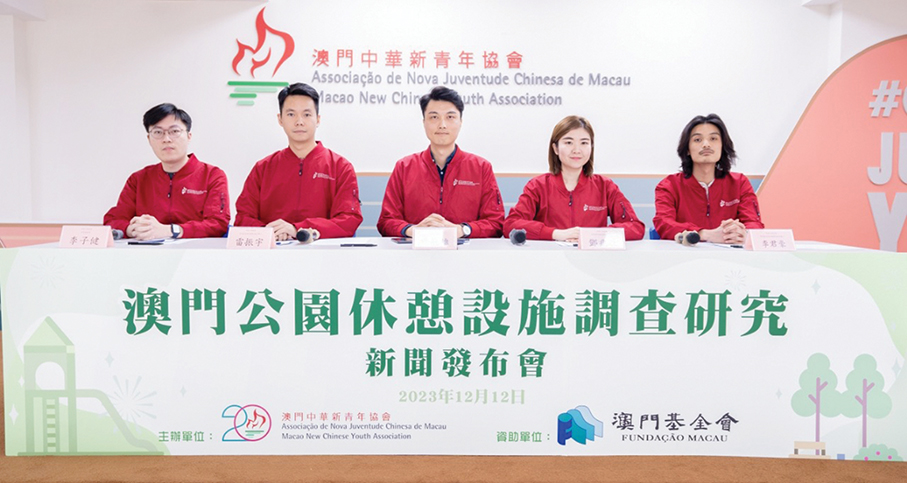The Macao New Chinese Youth Association (MNCYA) yesterday hosted a press conference at its centre in the Macao Daily News Building on Avenida de Venceslau de Morais, where five representatives of the association presented their findings of a survey titled “Macau Parks and Leisure Facilities Survey”, according to which 49.1 percent of the 634 surveyed local youngsters said that the overall public leisure spaces in Macau were insufficient.
The research project, funded by the Macau Foundation (FM), was carried out from September to October, during which a total of 634 valid questionnaires were collected from local residents aged between 18 and 44 based on random sampling, in order to identify areas of improvement for Macau’s public recreational facilities, and gain insight into young locals’ perceptions and expectations regarding public parks and leisure spaces, according to a statement by the association.
During the press conference, the association’s representatives noted that 43.1 percent of the respondents had been regularly using outdoor recreational facilities for physical activities at least once a week, while about 17.7 percent said that they had not been to any recreational facility this year. Meanwhile, 49.1 percent of the respondents said the public recreational facilities in Macau were “insufficient”, indicating an imbalance of supply and demand for leisure space, according to the representatives.
The statement said that 49.4 percent of the surveyed youths commented positively on “the current situation of Macau’s parks and leisure areas”, with playgrounds, shaded sitting-out areas and jogging tracks being the most favourable facilities.
Using a 5-point Likert scale (an ordinal scale used to assess levels of satisfaction or agreement in a score from 1 to 5, with the higher score implying a higher level of satisfaction or agreement), the findings show that the respondents were most satisfied with the public recreational facilities’ greenery conditions, with the average score of 3.77 points, followed by family-friendliness and cleanliness (each 3.74 points). On the other hand, “shade provision” received the lowest satisfaction level from the respondents with the average score of 3.05, indicating the need to install more effective shade areas for the outdoor recreational facilities, the statement added.
Based upon the findings of the survey, the representatives suggested that the government increase the proportion of green and leisure spaces in its land use plan of the Zone A land reclamation area, while at the same time providing more shaded areas in the existing recreational facilities, and incorporating shade provision in the design of any new public park.
Meanwhile, they pointed out that employing “user-centred design” techniques, such as stakeholder consultation, in the planning of public parks as well as other recreational areas, would be beneficial for identifying details about the needs of people who will be using the leisure spaces, and thus encouraging community participation.
They added that Macau’s public parks should provide more access to grassy areas, which are usually the favourable spaces for outdoor activities such as picnicking and camping. “Most urban parks in Macau are designed with small and ornamental lawns that are not intended for foot traffic, leaving a very few options in the city that permit the public to access lawns,” they said, underlining the importance of creating more accessible green spaces, which “can help people get closer to nature and therefore increase their physical and mental wellbeing”.

This handout photo provided by the Macao New Chinese Youth Association (MNCYA) shows its five representatives posing during yesterday’s press conference about a survey on Macau’s public recreational facilities, at its centre on Avenida de Venceslau de Morais.







